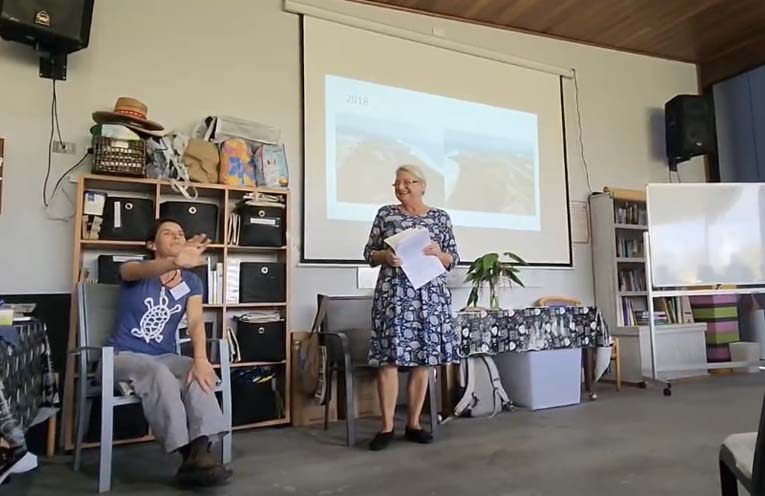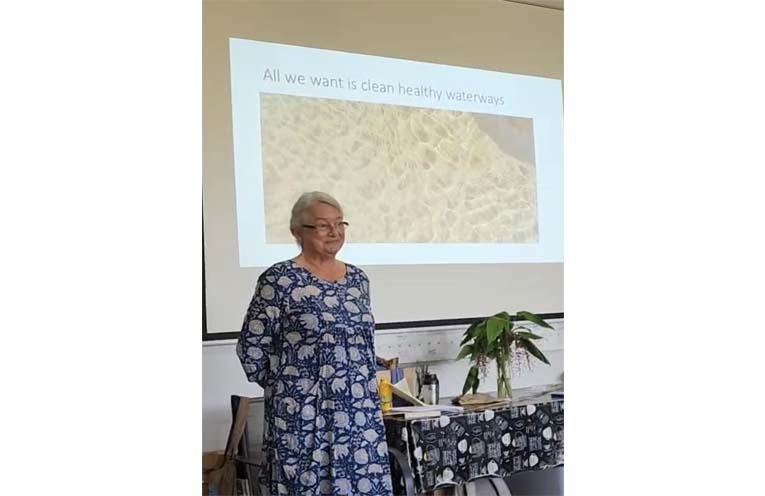
MAXINE Rowley from the Sandy Beach Action Group Inc (SANDBAG) presented the main outcomes of a study conducted throughout 2021 which was undertaken by members of the local Sandy Beach community who have ongoing concerns about the health of Hearnes Lake catchment.
The study explored the type and extent of agricultural chemical contamination in tributaries feeding into Hearnes Lake during rain events.
 Advertise with News of The Area today.
Advertise with News of The Area today.It’s worth it for your business.
Message us.
Phone us – (02) 4981 8882.
Email us – media@newsofthearea.com.au
With the report released late last year, Ms Rowley, an environmental scientist, presented the facts and figures to interested individuals on Thursday 23 February at the Woolgoolga Community Gardens, with the meeting facilitated by Sarah Maclagan.
“The next step is the implementation of methods such as on-farm water recycling systems, designed to prevent contaminated water from reaching the waterways,” Ms Rowley told News Of The Area.
“After this the restoration of a clean and healthy Hearnes Lake can begin.”
For the study a community-based sampling methodology was produced and implemented by local residents, and water samples were collected during rainfall-induced flows at five sites in the catchment, three times throughout the year.
The study found twelve different pesticides in the Hearnes Lake catchment waterways over three sampling events.
“Most are highly toxic to a variety of aquatic organisms, and some are highly toxic to humans and other mammals,” Ms Rowley said.
“Two are suspected of causing cancer.
“Seven are listed as most dangerous by the National Toxics Network.
“Six are under review or proposed to be reviewed by the Australian Pesticides and Veterinary Medicines Authority.
“Eight are banned by the European Union, and one has been illegal in Australia since 2006,” she said.
The SANDBAG report states that the most obvious and alarming pattern was the repeated detection of multiple (at least six) pesticides at one site.
“It took just an estimated 20mm of rainfall to induce runoff at this site, and over the year of the study alone, adequate rainfall to produce this pesticide laden runoff occurred eighteen times.”
Aerial photos show significant agricultural development upstream of this site, most of which has been identified as blueberry farms.
The land slopes steeply and there appears to be minimal vegetation around the creeks.
The report suggests it is possible that this type of landscape is not suitable for intensive agricultural practices.
The pesticide Imidacloprid was repeatedly detected indicating widespread and possibly frequent contamination of the waterways.
Residues of this insecticide above safe limits have previously been found in prawn flesh and in the water of Hearnes.
It is known to have damaging impacts on prawns and oysters even at low concentrations.
“The pattern of detections indicates the main source of Imidacloprid may have been discharges from hothouses (tunnels) growing cucumbers or tomatoes.
“Current accepted methods for management of this chemical appear inadequate to prevent continued pollution to downstream environments,” noted Ms Rowley.
The most significant damaging effects of these pesticides, the study suggests, are likely to be on the aquatic life that provides a vital food source for this ecosystem.
The report states that this will reduce the health of Hearnes Lake, which is a part of the Solitary Islands Marine Park (SIMP), and threatens to impact on Flat Top Point, the site of the most biodiverse Rocky Shore habitat in the SIMP.
Pesticide pollution of Hearnes Lake also presents a potential Public Health risk to people who use the lake for swimming, fishing and boating, and to anyone eating seafood sourced from the lake.
One local researcher was recently quoted as stating, “Hearnes Lake isn’t dead but it’s nearly dead.”
The researchers say in the report that significant loads of pollution entering Hearnes Lake waterways is damning evidence of a failure of will or capacity by the responsible authorities, and the relevant agricultural industries, to act decisively to protect this section of the SIMP and its irreplaceable environmental and community values.
This paper was prepared on behalf of Sandy Beach Action Group Inc. (SANDBAG) for the City of Coffs Harbour.
This project was funded via the Coffs Harbour City Council’s Environmental Levy program.
To access the final report, scroll down to ‘Identifying pesticides in Hearnes Lake catchment waterways’ at https://www.coffsharbour.nsw.gov.au/Environment/Compliance-and-reporting/Monitoring-our-waterways.

